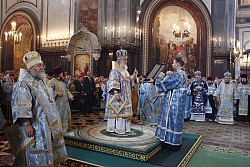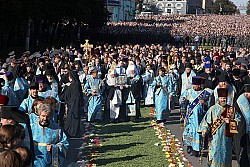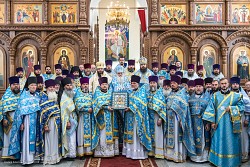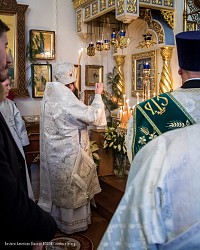Its history reflects virtually the entirety of Russia’s history from the times of the Tatar-Mongol yoke up to the present day. The refugees who found themselves outside their homeland called it the " Hodegetria" (Directress, though often translated as Protectress), because they placed their trust in God and His Most Pure Mother alone.
It was providential that our interview with the vicar of the Eastern American Diocese, Bishop Nicholas of Manhattan, took place on the feast of the Kursk Root Icon – the 725th anniversary of her miraculous appearance. We read in chronicles that, "on the feast of the Nativity of the Mother of God in 1295, a few residents of the city of Rylsk came to hunt on the Tuskar River. On its shores grew an enormous elm. One of the hunters came up to the tree and noticed a small icon lying face down on its roots. He lifted it up and a spring began to flow from under the elm. Realizing that this was no accident, the hunters decided to leave the icon where they found it, and erected a small chapel for it."
The icon was later called "Root," because it was found at the roots of a tree. And "Kursk," because it is about twenty miles down the river to Kursk from the place of its acquisition. Today, the site is home to the Kursk Root Hermitage, a revived monastery in honor of the feast of the Nativity of the Most Holy Theotokos and the Kursk Root Icon of the Mother of God.
On its holiday and jubilee anniversary, coinciding with the radiant feast of her miraculous Nativity, September 8/21, the icon traveled to its first home in America, the New Root Hermitage in Mahopac, NY, where the émigrés had founded a monastery in honor of its ruined Russian forebear. That day, in the Church of the Nativity of the Theotokos, the First Hierarch of the Russian Church Abroad, Metropolitan Hilarion of Eastern America & New York, celebrated the Liturgy.
"In accordance with tradition, the Kursk Root Icon should be spending these days in Kursk, and before that, in the first days of September, be visiting Belgorod," Bishop Nicholas relates.
‒ During these days, I prayerfully remembered our brothers in Kursk: Metropolitan Herman of Kursk & Rylsk and the deputy abbot of the monastery, Abbot Seraphim (Kotelnikov). It is always a special joy for them. On that day, they wrote to me from Kursk: "We served at the holy spring and celebrated Divine Liturgy in the cathedral. During the divine services and in the refectory, they fondly remembered last year. We thanked the Lord and the Theotokos. The brethren and our new friends send their regards and greetings."
The Kursk Icon unites us. Although the events of this year have hindered this, during these festal days I prayed for everyone at home, in the cathedral in Manhattan.
The Kursk Icon has been in America for 70 years. First, after the Synod of Bishops moved from Mahopac to New York City, on the West Side of Manhattan, and now in the current Synodal Residence of the First Hierarch of the Russian Church Abroad, donated to our Church by Serge Y. Semenenko, where the main cathedral is consecrated in honor of Kursk Root Icon of the Sign and the lower church is dedicated to Venerable Sergius of Radonezh, Serge Semenenko’s the Heavenly patron, in his memory. For all these decades, the Kursk Icon has been a special consolation for those who were forced to leave their homeland.
‒ Your Grace, after arriving in America, when did the Kursk Icon begin to make pilgrimages, both throughout the country and abroad?
‒ During the Second World War, our icon visited parishioners in their houses in Belgrade, Berlin, and Geneva. In November 1950, Metropolitan Anastassy arrived in America, and in January 1951, the Kursk Icon itself arrived, accompanied by Archimandrite Averky (Taushev; later Archbishop, +1976). The pilgrims went to the New Root Hermitage, and then to New York City to venerate her.
Four months after the wonderworking icon arrived in America, it began its journey to the parishes of the Russian Church Abroad. The first was a trip to California in the post-Paschal days of 1951. In Joy of All Who Sorrow Cathedral in San Francisco, up to 700-800 pilgrims gathered for molebens. The wonderworking icon visited the Our Lady of Vladimir Convent, St. Seraphim Church in Monterey, and Russian social organizations, while molebens were constantly served in the homes of parishioners. In total, more than two hundred such molebens were served. Healings were performed through the faith of the people of San Francisco.
Summer pilgrimages with the Kursk Icon to the West Coast became a tradition, and by 1953, in a summer cottage, at the Church of All Russian Saints in Burlingame, they set up a Synodal metochion and summer residence for the Metropolitan and the wonderworking icon. The Kursk Icon went there in the summer, first with Metropolitan Anastassy, and then with Metropolitan Philaret.
In October-November 1967, the Kursk Icon visited parishes in South America for the first time.
‒ And there occurred one of the miracles of the Kursk Icon…
‒ Archbishop Theodosius of São Paulo & Brazil at that time was seriously ill, in a semi-conscious state and was awaiting the arrival of the wonderworking icon. When the clergy, singing the troparion with the holy icon, approached Vladyka’s cell, to everyone's amazement, they saw Archbishop Theodosius standing in a cassock at the entrance to his cell. Making a prostration to the ground, he venerated it with tears.
On that pilgrimage, the Kursk Icon also visited the Russian High School in Buenos Aires and made a strong impression on the students and teachers. After a moleben before the icon, one of the schoolgirls was healed.
In June 1968, with the blessing of Metropolitan Philaret, Bishop Nikon (Rklitsky; later Archbishop, +1976) went with the Kursk Icon to Europe, where he visited parishes, monasteries and sketes, summer camps, and nursing homes in England, Belgium, Switzerland, Germany, France, and Spain.
‒ In the year of the Millennium of the Baptism of Rus’, the Kursk Icon graced all of the celebrations in America with its presence….
‒ And also in Australia, Europe, and Canada, and it visited parishes in Chile, Argentina, and Brazil. In the 1980s, the Kursk Icon generally began to travel more often. And 25 years ago, in the year of the 700th anniversary of its appearance, the holy icon visited all of the dioceses in the United States.
To this day, in the Eastern American Diocese, she is present at services and visits the homes of those who cannot come to church themselves. We adhere to this principle: if the Kursk Icon is invited, we try not to refuse.
‒ The Kursk Icon began to travel even more actively in the last 20 years, especially after the reunification of the Russian Church in 2007, which providentially happened on the day of the Ascension of the Lord…
‒ At the time, different proposals were put forward, how and when to organize this celebration. It was decided that on Thursday, the solemn divine service would be held in Christ the Savior Cathedral and the signing of the Act of Canonical Communion. On Friday, a large group of our clergy went to the Lavra, to Venerable Sergius, where Archbishop Kyrill of San Francisco & Western America served a moleben at the relics of St. Sergius. The pilgrims spent the day in the Lavra and visited other churches in its vicinity.
On Saturday, the church at the Butovo firing range was consecrated, and on Sunday, the clergy held a joint service in Dormition Cathedral in the Moscow Kremlin. On Monday, almost the entire delegation returned to America, and Metropolitan Laurus and those accompanying him went to Kursk, also visiting Kiev and Pochaev. At that time, the Kursk Root Icon was in Australia.
In 2008, both Metropolitan Laurus and Patriarch Alexey II reposed in the Lord. In May 2008, Archbishop Hilarion (Kapral) was elected First Hierarch of the Russian Orthodox Church Outside of Russia. A year later, the Synod of Bishops blessed the pilgrimage of the Kursk Icon to Russia. 90 years later, in 2009, the holy icon returned to its native sites.
On September 11, our delegation, headed by the Primate of the Russian Orthodox Church Outside of Russia, departed New York City and arrived in Moscow the following the morning, on the feast of the Holy Right-Believing Great Prince Alexander Nevsky.
Our Metropolitan Hilarion led the Sunday Liturgy in Christ the Savior Cathedral. The Kursk Icon stayed in Moscow until September 22, and the next day it flew to Kursk. The Kursk icon was greeted by hundreds of thousands of people. I have never seen anything like it! We approached the Cathedral of the Sign and the moleben was officiated by Patriarch Kyrill. The Kursk Icon stayed in the cathedral for veneration for almost two weeks.
Every year since then, the Kursk Icon has visited Russia, Kursk and another diocese.
‒ Tell us, what other places has the Kursk Icon visited over the years?
‒ In May-June 2010, the Protectress visited Kiev, Sumy, and Kursk. In the summer and autumn, processions are held in Kursk. Our icon is usually present in the fall. Beautiful services happen during these days. Prayers and akathists are sung.
In 2011, we performed a pilgrimage with the Kursk Icon to Kazakhstan and Kursk; in 2012, to Kursk, Belgorod, and Perm; in September 2013, we went to Kursk, and in November to Japan and Vladivostok; in 2014, we visited Voronezh and Kursk; in 2015, Kursk, Yekaterinburg, Ufa, and Salavat; in 2016, we went to Kursk and Saransk; in 2017, we went on pilgrimages to Kursk and Orenburg; in 2018, we visited Kursk and Riga; in August 2019, we went to Saratov for the feast of the Dormition of the Theotokos, and in the fall, we visited Uzbekistan (Tashkent), Tajikistan (Dushanbe), Kyrgyzstan (Bishkek), and Kazakhstan.
Over the past 10 years, our world-traveling icon has also been in the dioceses in America and in Germany, Canada, England, Australia, and New Zealand.
The 2020 pilgrimages had to be canceled ‒ this is how the Lord humbles us.
‒ Was this period the only one in recent years when the Kursk Icon did not travel outside the Diocese?
‒ Upon its arrival in America, the Kursk Icon did not leave the Synod of Bishops very often. After his election as First Hierarch, Metropolitan Vitaly (Ustinov) suggested that the icon should visit the dioceses more often and support our faithful (in 1993, he visited almost all parishes of the Diocese of Australia & New Zealand himself). Accompanying the icon in 1995, the 700th anniversary of her appearance, Archpriest George Larin traveled with the icon to all of the dioceses of the Russian Church Abroad.
‒ Is there a tradition for where the Kursk Icon greets Nativity and Pascha?
‒ During these holy days, the Kursk Icon stays at home, at the Synod of Bishops.
But I remember that once the icon was at Holy Trinity Monastery for Passion Week and Pascha, and on Christmas Day was in Seattle. In 2019, for Nativity and until the end of January, the Kursk Icon left for Australia. But these are rare cases.
‒ Sometimes you will hear that wonderworking icons undergo some changes over the years ‒ the icon can sometimes smell sweet and even change color and weight. Have you noticed something similar happening to the Kursk Root Icon?
‒ Very often, people can sense a fragrance from the icon, the smell of roses. And some feel the special weight of the icon. After all, the image itself is small. Sometimes, I will give the icon to the bishops, priests, while visiting houses I give it to someone to hold and pray, and everyone who takes the Kursk icon says the same words ‒ how hard it is. It is my opinion that for over than seven hundred years, many have prayed in front of the icon, have repented, have asked for help, have given thanks. And the Mother of God hears everyone, understands everything and accepts everyone. Only during the war, how many believers wandered around Europe, tried to preserve their faith and culture, and at the slightest opportunity tried to venerate the icon. That is why such a weight is a spiritual weight, one might say, what a loving Mother can only bear. And she brings all our petitions to her Son, asking for help, support, and healing.
I recently visited a family near the town of Nyack. I blessed the house, and then invited those who wanted to hold the Kursk Icon. The father of the family had never held this icon, took it, and said with surprise, "How difficult! I did not expect this!"
‒ This year, there was an aerial procession with the Kursk-Root Icon. Was this the first time?
‒ This year is not easy. We saw that already in April processions of the cross were held in Moscow, Kiev, and Minsk. One parishioner suggested that we arrange a procession with our icon. And here was a person who could help with this. With the blessing of Metropolitan Hilarion, a procession was scheduled for Lazarus Saturday. We discussed the details with Archpriest Serafim Gan and the pilot. But on Lazarus Saturday, there was a strong wind and rainy weather was predicted. We had to leave for Long Island at 6 o'clock in the morning. The weather did not change, and we decided to make peace with it and postpone the flight.
Passion Week and Pascha are over. We have not forgotten our intention to consecrate New York and the surrounding area. We decided to fly on the feast of Mid-Pentecost. On the day of the feast, early in the morning, we prayed with the Kursk Icon in St. Seraphim Memorial Church in Sea Cliff, New York. After the Liturgy, Fr. Serafim, Protodeacon Eugene Kallaur, having prayed, we arrived at the plane, where our kind parishioner-pilot met us.
We understood that processions have always helped the people to unite and get rid of troubles. We had a plan to fly around all areas of the city and New York suburbs in New York and New Jersey ‒ nearby New York ‒ and invoke the blessing of the Mother of God on our land and its inhabitants. During the flight, we read the Akathist to the Kursk Root Icon and I blessed all four sides [of the city] with the icon. We did not advertise our flight in advance, and when everything was over, only then did we inform people that the Mother of God had consecrated our land with an air procession of the cross.
‒ This year, due to the situation around the world, all foreign pilgrimages had to be canceled, but the Kursk Icon still consoled believers in both New York and the Eastern American Diocese…
‒ After the feast of Holy Pascha, the Kursk Icon was supposed to go to San Francisco and stay in the Western American Diocese until the feast of Pentecost, and then, until Transfiguration, to the German Diocese. In October, a trip was planned to Russia ‒ to Kursk and Belgorod, and in winter the icon was to visit Europe. All these trips had to be canceled.
Nevertheless, with the easing of quarantine on the East Coast, we had the opportunity to make pilgrimages with the Kursk Icon to the parishes of the Eastern American Diocese: in July, the icon attended the St. Vladimir Celebrations at the Memorial Church in Jackson, NJ, during the "Royal Days" ‒ July 17-20 ‒ the icon was at Holy Trinity Monastery in Jordanville, visited the Church of Myrrh-bearing Women in Brooklyn, for the patronal feasts in Lakewood and the New Kursk Root Hermitage in Mahopac, and at St. John the Baptist Cathedral in Washington. On Thanksgiving Day in November, according to tradition, I am going to visit St. John the Baptist parish in the capital again: we will thank God, we will celebrate Liturgy, a thanksgiving moleben and akathist in front of our wonderworking icon, and we will visit parishioners. In December, the Kursk Icon will bless our patronal feast of the Synodal Cathedral of the Sign.
Despite the restrictions, churches in the Diocese are open; people come to pray and receive consolation.
The Kursk icon is kept on the East Coast, in New York City, at the Synod of Bishops. On the West Coast, in Joy of All Who Sorrow Cathedral in San Francisco, there are the incorruptible relics of St. John, Archbishop of Shanghai & San Francisco, the Wonderworker. And together they embrace our country like a spiritual cloud. America needs prayers, protection, and the intercession of the Mother of God. And we fulfill obedience from God and the Mother of God - we preserve the icon and make it available to believers.
Interviewed by Tatiana Veselkina.








